|
|
Amber
|
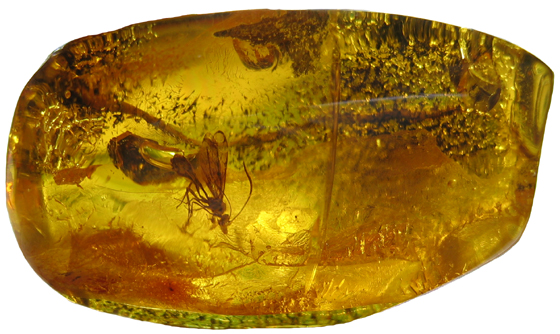
|
Baltic
Amber with Inclusion
Order Hymenoptera
Specimen 8mm
Cenozoic; Paleocene; Eocene
Yantarny, Kaliningrad, Russia
4.5 cm long x 3 cm wide x 1.5 cm thick
Click on specimen to open up a close-up window. |
Amber
is referred to as petrified tree resin or sap. I prefer
petrified tree resin as the term sap refers to fluids transported
by xylem or phloem tissues (Raven, Evert, & Curtis,
1981, p. 659). Conifers and some deciduous trees produce
resin
in response to injury.
Resins
are viscous liquids that contain
volatile terpene compounds and organic solids. Under the
right conditions resins polymerize and harden
with age, turning into copal. After several
million
years
copal matures
into
amber.
Tree resin breaks down when exposed to drying and oxidation within
just a few thousand years. It is not surprising then that amber
deposits do not represent forest floor environments. Amber deposits
usually represent marine environments. Amber deposits form when
resins produced in
forests are transported by water to oceans
or
lakes,
where
they
are deposited
into
the sedimentary layers. Quick transport and deposition protects
the resin from weathering. Once deposited, the resin chemically
matures into intermediate forms called copals and finally into
amber after millions of years. The amberization process is estimated
to take between 2 and 10 million years. However, the type of depositional
environment may also affect the time needed for amberization. Amber
from Borneo is found in sand and clay sediments deposited in a
deep ocean 12 million years ago. The material that comes out of
the sandstone has matured into amber, while the specimens from
the clay are still copal (Ross, 2010, pp 8-9).
Petrified resins have been found
in Carboniferous, Triassic, and Jurassic
deposits,
but
represent
minute amounts
of
resins
produced inside trees. Resin that collects inside trees
does not act as an insect trap. The first occurrence of fossil
containing amber
is Cretaceous
in age. The majority of amber deposits that contain fossils
were formed during the Cenozoic (Weitschat & Wichard, 2002,
pp.9-10).
Fossils entombed in amber are referred to as inclusions.
Although the organisms often look complete, most appear
to be thinly lined
hollow spaces (Weitschat & Wichard, 2002, p. 29). However,
under the right conditions the internal organs can be well
preserved.
The
preserved
internal
organs of
a bee
exhumed from Dominican amber have been imaged using an electron
microscope
(Grimaldi & Engel, 2005, p. 59). Studies using scanning
electron microscopes as well as transmission electron microscopes
have revealed internal organ preservation in Baltic amber
spiders and gnats. It seems that many orangisms are preserved
through
mummification. In the process of mummification, dehydration
results in up to a 30% decrease in volume of tissues. The
decrease in tissue volume gives the organisms the appearance
of an
empty husk (Selden & Nudds, 2004, p. 134).
The
shape of a specimen can be a clue to whether the amber
formed inside the tree as an internal resin accumulation
or outside the tree as an external resin accumulation.
Resin can collect inside
the
void of a tree,
drip
off
a branch,
or flow along the outer bark. Resin that collects inside
a tree usually does not contain fossils. Resin that accumulates
on the outside of a tree can act as an insect trap. Fossils
are almost exclusively found in specimens formed by successive
resin
flows that collected on the outside of the tree.
These specimens are referred to as Schlaube (Weitschat
& Wichard,
2002, p. 12). Organisms become trapped in the
resin and are then covered by a successive resin flow.
You can usually see the plane representing a successive
resin flow;
it often looks like a fracture in the amber.
Amber
can represent a brief snapshot in time. Amber has preserved
insect developmental stages, mating, egg
laying, brood care,
feeding, as well as various symbiotic relationships. Amber with
and without fossils can be quite valuable so, it is
often faked. See Ross (2010) for an excellent discussion
regarding materials used to make fake amber and tests
that can be used to distinguish real amber from imitations
(pp. 11-15).
|
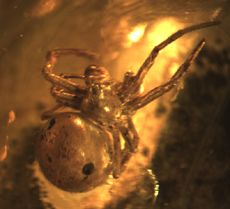 Spider
Spider
Cenozoic; Paleocene; Eocene
Primorskoje, Kaliningrad, Russia |
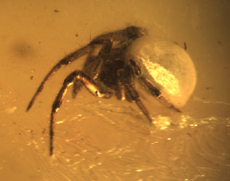 Spider
Spider
Cenozoic; Paleocene; Eocene
Primorskoje, Kaliningrad, Russia |
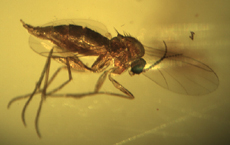 Insect in Amber
Insect in Amber
|
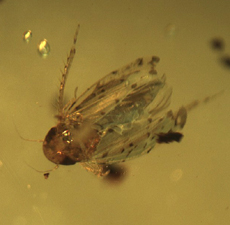 Insect in Amber
Insect in Amber
|
Bibliography
|
Grimaldi,
D. & Engel, M.S., (2005). Evolution of the Insects.
New York: Cambridge University Press.
Raven,
P.H., Evert, R.F., & Curtis, H. (1981). Biology
of Plants [3rd Ed]. New York: Worth Publishers,
Inc.
Ross, A. (2010). Amber:
The Natural Time Capsule. New York:
Firefly Books.
Selden
P. & Nudds, J. (2004). Evolution of Fossil Ecosystems.
Chicago: The University of Chicago Press.
Weitschat, W. & Wichard, W. (2002). Atlas of Plants and Animals in
Baltic Amber. Munchen: Verlag Dr. Friedrich Pfeil.
Wilhelm Janzen, J.(2002). Arthropods in Baltic Amber. Germany: Ampyx
Verla. |
|


